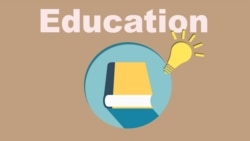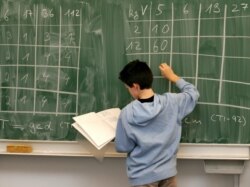Students from China and Singapore came out on top in an international survey of educational achievement.
Results of the 2018 Program for International Student Assessment, or PISA, were released Tuesday. The test is given every three years to 15-year-olds around the world. It measures their knowledge in reading, science and mathematics.
The best-performing students in all three subjects were in China. They attend schools in and around Beijing and Shanghai, and two provinces: Jiangsu and Zhejiang.
Singapore finished in fifth place in the study.
Overall, the test results show American students scoring above average in reading and science, but below average in math.
The test is administered by the Organization for Economic Cooperation and Development (OECD).
Officials reported that about 600,000 students in 79 nations and educational systems took part in the two-hour computer-based exam last year. They said schools in each country are chosen randomly to make sure that students come from a wide mix of backgrounds and abilities.
PISA is the largest measure of international education performance.
The test scores are watched closely by education policy makers.
Some of the findings:
Here are some of the PISA findings:
- The average U.S. scores have not changed in a major way in any of the three subjects since 2015. The U.S. scores are mostly unchanged since when the test was first given in 2000 for reading and, in 2003, for math. American science scores have risen since 2006.
- Out of the 79 areas, only seven have seen an improvement in their PISA scores since they started offering the test. The seven are Albania, Colombia, Macau, Moldova, Peru, Portugal and Qatar.
- The OECD is a group of 36 mostly industrial countries, including the United States. Financing -- the amount of money spent on education -- is important, but not always necessary for high test scores. Take Estonia, for example. It was one of the top scoring countries, yet education spending there is 30 percent below the OECD average.
- With reading being the main focus of the test this year, one of every four students in OECD countries could not complete basic reading tasks.
- On average across the OECD countries, one in 10 disadvantaged students was able to score in the top quarter of the reading performance of their country.
U.S. and China Results
The U.S. results showed that the highest performing students were doing better in reading and math, while the lower-performing students did not improve.
This is similar to results from another nationwide test, the National Assessment of Educational Progress.
“It’s another red flag that this is something to think about,” said Peggy Carr, the associate commissioner for the National Center for Education Statistics. She noted that the United States is “clearly struggling in math.”
What is not clear about the group of Chinese students tested is whether they represent all Chinese students. Carr noted that the four test areas are home to more wealthy people than China as a whole.
The Chinese areas displaced the top school system in the 2015 PISA, the Asian city-state of Singapore.
Tom Loveless, an educational researcher from California, said the Chinese provinces that were tested saw a substantial increase in their scores. He said China is the only country where the national government chooses the provinces that are tested.
“It still makes it very difficult to interpret the Chinese scores,” he said.
Loveless describes the overall performance of American students as mediocre.
“The U.S. is basically doing what it’s done since PISA started, which is hanging around the middle” of the group,” he said.
Andreas Schleicher is Director for the OECD’s Directorate of Education and Skills. He said there is hope for countries where there is not much difference in the performance of students from wealthy and poor backgrounds. Education, he says, remains a way for poor children in some countries to be successful.
I'm Caty Weaver,
And I’m Anne Ball.
Anne Ball wrote this story, with information from Reuters and the Associated Press. George Grow was the editor.
What do you think of this story? Write to us in the comments section below.
_______________________________________________________________
Words in This Story
achievement – n. something that has been done or achieved through effort : a result of hard work
score – n. the number of points, goals, runs, etc., that each player or team has in a game or contest
average - adj. a level that is typical of a group, class, or series : a middle point between extremes
randomly – adv. chosen or done without a particular plan or pattern
background – n. the experiences, knowledge and education in a person's past
fine-tune – v. to make small changes to something to improve the way it works to make it just right
focus – n. a subject that is being discussed or studied : the subject on which people's attention is focused — usually singular
disadvantaged – adj. lacking the things—like money and education-- that are considered necessary for an equal position in society
quarter – n. one of four equal parts of something
red flag – n. a warning sign
mediocre – adj. not very good










